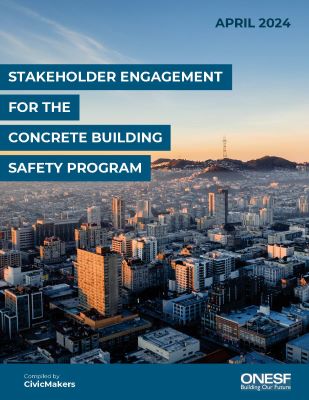Concrete Building Safety Program
The City of San Francisco is developing a program to identify and strengthen vulnerable concrete buildings. The City brought together a working group of people representing stakeholders potentially impacted to highlight top concerns and make recommendations about the implementation of a potential Concrete Building Safety Program.

Some types of concrete buildings are now known to be unsafe in a large earthquake. Older concrete buildings have suffered catastrophic collapses in recent earthquakes in Mexico City and Christchurch, New Zealand. The City of San Francisco is developing the Concrete Building Safety Program (CBSP) to identify and address vulnerable concrete buildings in San Francisco, with the following goals:
- Protect life and public safety
- Preserve housing and critical use
- Protect the economy
- Preserve city vitality and character
- Speed earthquake recovery
The City convened a Working Group of internal and external partners to provide guidance and feedback to City staff on the development of the Concrete Building Safety Program. The goal of this working group was to help ensure that the Program is technically sound, increases the resilience of the community, and is practical to implement by building owners. This Working Group met eight times between October 2022 and September 2023.
The CBSP Stakeholder Engagement Report details the Working Group’s engagement activities, review of technical criteria, and recommendations for the development of the Concrete Building Safety Program.
Read the CBSP Stakeholder Engagement Report by clicking on the report cover image above.
Why is it important to focus on concrete buildings?
Certain older concrete buildings are known to be potentially dangerous in earthquakes and may pose a risk of death and injuries to their occupants. Serious damage or failure of even a few concrete buildings will have disproportionately large impacts on the City’s recovery, including impacts to surrounding buildings and neighborhoods, commercial activity, significant loss of housing, and potential loss of life. Concrete buildings contain much of San Francisco’s affordable housing stock. Many smaller concrete buildings support production, distribution and repair uses, as well as neighborhood serving grocery stores and pharmacies. Identifying and addressing vulnerable concrete buildings now will protect life and safety, preserve housing and critical buildings, protect the economy, and prepare the City for a smoother post-earthquake recovery. Retrofitting older concrete was identified as a priority in the Tall Buildings Study and Earthquake Safety Implementation Program (ESIP).
Which concrete buildings will the program address?
The concrete building safety program aims to address two types of potentially hazardous concrete buildings: Non-ductile concrete buildings and rigid-wall-flexible-diaphragm buildings (also called “tilt-ups”).
Concrete buildings are hard to identify from the street. To determine whether a building is a potentially hazardous concrete building, a qualified structural engineer needs to inspect the building or its drawings.
What progress has the City made so far on the Concrete Building Safety Program?
In May 2025, the Board of Supervisors passed legislation to identify concrete and tilt-up buildings through a screening program. This legislation also established voluntary retrofit standards in the San Francisco Existing Building Code.
In 2022, the Office of Resilience and Capital Planning (ORCP) contracted with CivicMakers, LLC to conduct a robust stakeholder engagement process to surface top concerns and priorities and make recommendations for the development of the Concrete Building Safety Program. This process included 34 stakeholder interviews across 31 organizations, 8 working group meetings over 11 months, one concrete building walking tour, and three topic-specific focus groups.
ORCP also contracted with the Applied Technology Council (ATC), a non-profit organization that convenes leading structural engineers, to develop technical recommendations and standards.
To learn more about the recommendations, please read the Stakeholder Engagement Report by clicking on the report cover image above.
In April 2024, Mayor London Breed issued Executive Directive 24-01 directing staff to draft legislation related to the Concrete Building Safety Program.
What are the next steps of the Concrete Building Safety Program?
The Department of Building Inspection (DBI) will kick off the screening program in Fall of 2025. DBI will contact building owners affected by this program to provide additional guidance.
To support buildings owners wishing to retrofit their buildings, ORCP is working with a consultant to develop a Financing Guide for concrete building retrofits. The Financing Guide will be finalized in Spring 2026.



